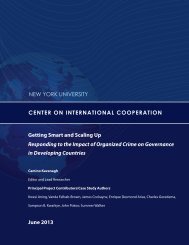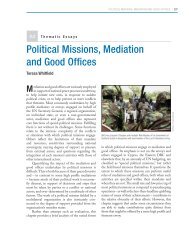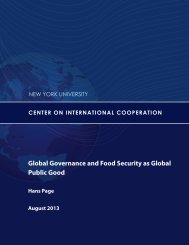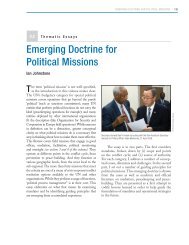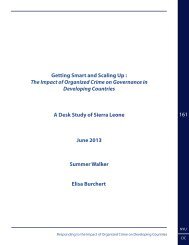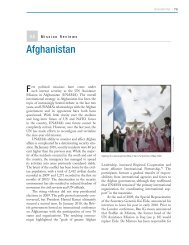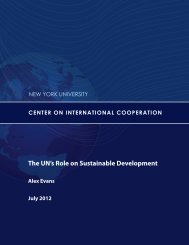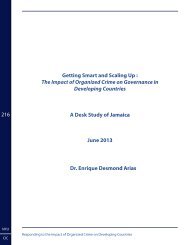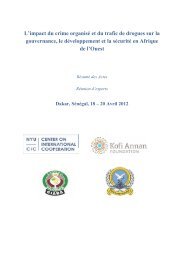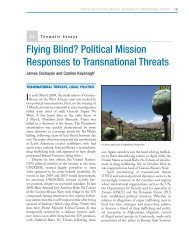here - Center on International Cooperation - New York University
here - Center on International Cooperation - New York University
here - Center on International Cooperation - New York University
You also want an ePaper? Increase the reach of your titles
YUMPU automatically turns print PDFs into web optimized ePapers that Google loves.
172<br />
II. The Nature, Scope, and Impact of<br />
Organized Crime in Sierra Le<strong>on</strong>e<br />
Sierra Le<strong>on</strong>e has l<strong>on</strong>g been a theatre for illicit operati<strong>on</strong>s.<br />
Diam<strong>on</strong>d smuggling and illegal logging have thrived for<br />
decades, as has the trade in small arms. More recently,<br />
c<strong>on</strong>cerns over a growing involvement in the internati<strong>on</strong>al<br />
drug trade have drawn internati<strong>on</strong>al attenti<strong>on</strong> back to<br />
Sierra Le<strong>on</strong>e. The pervasiveness of illicit activity in Sierra<br />
Le<strong>on</strong>e (and as noted above, West Africa in general) is<br />
usually linked to deep-rooted structural challenges related<br />
to the functi<strong>on</strong>ing of the political system, as well as limited<br />
enforcement capacities and weak infrastructure, porous<br />
borders, endemic corrupti<strong>on</strong> within the public sector,<br />
and the existing presence of local criminal groups. 80<br />
Decades of under-development and limited investment<br />
in employment opportunities and the provisi<strong>on</strong> of basic<br />
services have also provided a broad base of people for<br />
whom t<str<strong>on</strong>g>here</str<strong>on</strong>g> are limited alternatives to engaging in illicit<br />
activity.<br />
Violence and Organized Crime<br />
In Sierra Le<strong>on</strong>e, organized crime fueled violence and<br />
instability during the civil war. 81 The war was triggered<br />
in March 1991 when the Revoluti<strong>on</strong>ary United Fr<strong>on</strong>t, 82<br />
founded and led by Foday Sankoh, invaded the country<br />
with support from Liberia, Burkina Faso, and Libya. The<br />
government had little means to counter the invasi<strong>on</strong>.<br />
After the repressive pers<strong>on</strong>al rule of Siaka Stevens and the<br />
even more predatory regime of his successor, 83 instituti<strong>on</strong>s<br />
were weak and hollow. Mismanagement and pervasive<br />
corrupti<strong>on</strong> undermined the government’s legitimacy.<br />
As David Keen notes, “…much of the violence in Sierra<br />
Le<strong>on</strong>e in the 1990s can be explained as a successi<strong>on</strong> of<br />
attempts by those who have felt excluded or forgotten<br />
80. The Republic of Sierra Le<strong>on</strong>e (2010). Stability – Opportunity – Growth. ‘It’s Time,’ Joint Progress<br />
Report <strong>on</strong> the Agenda for Change, January 2009-June 2010.<br />
81. The eleven-year civil war resulted in over 70,000 casualties. More than half of the populati<strong>on</strong><br />
was displaced from their homes; thousands were injured or maimed. The country’s ec<strong>on</strong>omy<br />
succumbed; the physical infrastructure lay in ruins. What is more, the collapse of state authority<br />
was accompanied by a corresp<strong>on</strong>ding collapse in the socio-ec<strong>on</strong>omic fabric of the society. As<br />
Mary Kaldor and James Vincent rightly point out, “it was the experience of Sierra Le<strong>on</strong>e that led<br />
Robert Kaplan to coin the term ‘the coming anarchy.’” See: Mary Kaldor and James Vincent (2006),<br />
p. 6.<br />
82. One commentator describes the RUF as a group of “unemployed and unemployable youths<br />
[with] <strong>on</strong>e foot in the informal or underground ec<strong>on</strong>omy [and] pr<strong>on</strong>e to criminal behavior, petty<br />
theft, drugs, drunkenness, and gross indiscipline.” See: Ibrahim Abdallah (1998). „Bush Paths to<br />
Destructi<strong>on</strong>: Origin and Character of the Revoluti<strong>on</strong>ary United Fr<strong>on</strong>t/Sierra Le<strong>on</strong>e,“ pp. 207-208.<br />
83. During the Momoh administrati<strong>on</strong>, t<str<strong>on</strong>g>here</str<strong>on</strong>g> was the so-called Binkolo Mafia, a powerful cabal<br />
or exclusive circle of Limba politicians around the President. The name is derived from Joseph<br />
Momoh’s hometown, Binkolo.<br />
to draw attenti<strong>on</strong> to their grievances, perhaps even their<br />
existence. Whenever <strong>on</strong>e group managed to force its way<br />
into the ‘inner circle’ (as in the May 1992 coup or the RUF<br />
acquisiti<strong>on</strong> of cabinet posts in 1999) t<str<strong>on</strong>g>here</str<strong>on</strong>g> were always<br />
other groups left outside with an incentive to use violence<br />
to draw attenti<strong>on</strong> to their c<strong>on</strong>tinuing grievances…” 84<br />
Yet, the links between violence and organized crime in<br />
Sierra Le<strong>on</strong>e can <strong>on</strong>ly be understood against the backdrop<br />
of corrupti<strong>on</strong> and predati<strong>on</strong> that already existed in Sierra<br />
Le<strong>on</strong>e in the sense that “…the predatory exercise of state<br />
power by APC politicians established patterns of rule<br />
that were in<str<strong>on</strong>g>here</str<strong>on</strong>g>ntly incompatible with societal interests<br />
and the l<strong>on</strong>g-term reproducti<strong>on</strong> of elite dominance… A<br />
dysfuncti<strong>on</strong>al state increasingly at odds with society and<br />
incapable of performing basic tasks could not withstand<br />
the deadly struggle for access to the country’s mineral<br />
resources by elites and ordinary citizens alike.” 85 The<br />
appropriati<strong>on</strong> of elite modes of accumulati<strong>on</strong> by others<br />
gradually resulted in the transformati<strong>on</strong> of violence “from<br />
a tool of political dominati<strong>on</strong> to a means of criminal<br />
accumulati<strong>on</strong> by state agents.” 86<br />
While large-scale violence in Sierra Le<strong>on</strong>e has subsided<br />
since the civil war, outbursts of violence c<strong>on</strong>tinue to<br />
occur, especially in relati<strong>on</strong> to electi<strong>on</strong> cycles. In 2009, an<br />
important challenge to peace emerged when violence<br />
broke out in many parts of the country, including<br />
Freetown. It accumulated in the storming of the<br />
oppositi<strong>on</strong> party’s headquarters and an attempt to lynch<br />
a group of oppositi<strong>on</strong> youth members (who c<strong>on</strong>sequently<br />
also bel<strong>on</strong>ged to another ethnic group). The incident<br />
paralyzed the government and the entire country, yet<br />
was resolved through peaceful means and cemented<br />
in a Joint Communiqué initially between the two main<br />
parties, although it later expanded to include others. The<br />
Communiqué not <strong>on</strong>ly dealt with the immediate issues<br />
that had led to an escalati<strong>on</strong> of violence, but included a<br />
range of other vulnerabilities, including illicit activity, that<br />
were, and remain, potentially destabilizing. 87<br />
84. David Keen (2003), p. 290.<br />
85. Jimmy Kandeh (1999), p. 364.<br />
86. Ibid.<br />
87. Joint APC-SLPP Communiqué of 2 April 2009; and the Statement of H.E. the President [of<br />
Sierra Le<strong>on</strong>e] <strong>on</strong> the occasi<strong>on</strong> of the Signing of the Inter-Party Communiqué, April 2009.<br />
NYU<br />
CIC<br />
Resp<strong>on</strong>ding to the Impact of Organized Crime <strong>on</strong> Developing Countries



